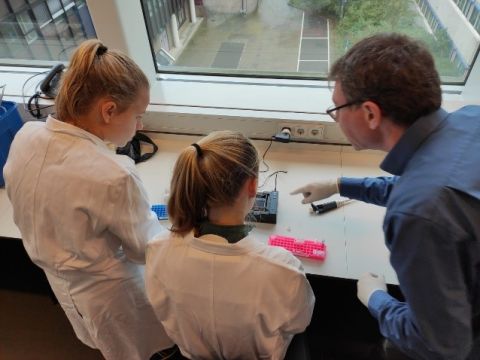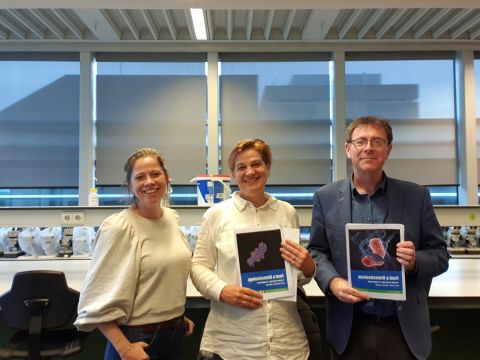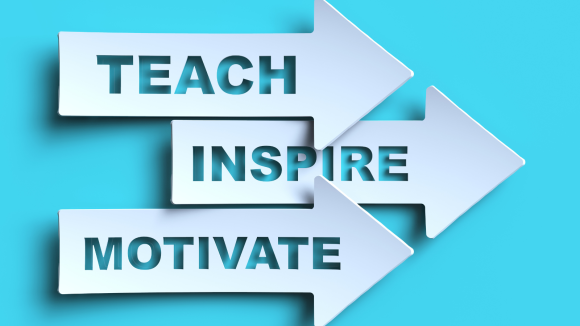Although many students think about careers as a linear journey that continues along roughly the same track, building over time, most professionals know the path can be not only windy but also multipronged, branching off in different directions. We connected with some of our ABE Master Teacher Fellows (MTF), many of whom are on their second career or more. At least three of these exceptional teachers—James Otero (ABE Puerto Rico), Declan Cathcart (ABE Ireland), and Laurie Jackson Grusby (ABE Massachusetts)—started as scientists.
James Otero, an ABE MTF at the Baldwin School in Puerto Rico, spent his whole life saying he was not going to be a teacher, despite feeling the draw from a young age and from his teacher mom. And for a time, it was true: He was a neuroscientist, going to graduate school in electrophysiology. But he always found ways to teach, whether in college at Michigan State, working with teachers back home in Puerto Rico, and ultimately now—both teaching high school science and training and teaching other teachers how to implement ABE labs.
“I remember all my whole life saying that I wasn't gonna be a teacher but I was always pulled in,” Otero says. “Even in sixth grade, they gave me a prize for being a teacher. But in college, I never took an education class. Yet, somehow, I ended up again in that classroom. I mean, I have no idea how, but it kept happening.”
Otero’s drive to teach now comes at a time in Puerto Rico when there is a crisis in the region’s education system, he says. “There is a large need for good teachers,” he explains. “And one of my goals is to make the classroom part of the community, while inspiring students to study science, to give it a try and not be scared because they are capable.”
One of the biggest challenges in Puerto Rico for the ABE program is that even before the recent Hurricane Fiona, many schools have been without electricity. That means that it is more complicated for teachers to be able to provide cold storage for the lab materials. Otero works with teachers throughout the region to problem solve, while also adapting the ABE curriculum content as needed for individual schools and teachers. The major focus of his Fellowship was using the virtual educational platform LabXchange and other tools to provide more differentiation in the classroom.
Declan Cathcart, an MTF who teaches at Temple Carrig School, outside of Dublin, Ireland, also came to teaching full time later in his career, after working for 10 years in industrial and university research biotech labs as a PhD scientist. “It wasn't something that was ever on my radar to become a teacher. But I ended up doing some part-time filling in for my sister-in-law. Within two weeks, that experience completely changed my career path. After 10 years on the bench, I thought, How come I never thought of teaching before? So, I signed up for a higher diploma in education and started a new path.”

ABE Ireland teacher Declan Cathcart with his students.
Now 20 years into teaching, Cathcart teaches biology, math, and biotech courses and is driven to open new types of doors for his students. “When you are lecturing biology in a hall of 53 students at university, it can feel like you are lecturing to an empty hall,” he says, “but when, you're in a classroom situation, it’s such a rewarding dynamic, where you have the privilege of being able to open students’ eyes to new ideas and different perspectives.”
Cathcart became involved with ABE early in 2015 after signing up for a workshop at a teaching conference. “ABE gave me the opportunity to introduce biotech into my biology classes in school without the prohibitive cost of equipment and materials,” he says. He then worked with the program to create a 10-week biotech module for his students, and he also piloted and reviewed other ABE program-wide activities.
“When the Master Teacher Fellowship came along, it was the perfect opportunity to develop activities for students in my biotech course, like new PCR ones, while also connecting with other teachers from around the world,” he says. “The Fellowship gave me the focus, structure, and timeline to develop something concrete.” Since then, Cathcart has successfully introduced his MTF labs to his own students in Ireland, as well as to a cohort of Dutch students in The Netherlands and to a group of teachers at a European science teacher conference in Prague earlier this year.

Declan Cathcart (far right) with Melanie Rosenhart and Andrea van Bruggen van der Lugt (left to right) from ABE The Netherlands, after a workshop for Dutch secondary school students, where they piloted new MTF labs.
Laurie Jackson Grusby’s switch to teaching came at a fortuitous time. A PhD geneticist, Grusby was running her own lab at Boston Children's Hospital for 10 years before transitioning to teaching. “I feel like I left at a pretty good time because I made a transition and was able to have my feet on the ground in my new career path, which was teaching science, prior to the pandemic,” she says.
Grusby was able to do a teaching fellowship program in the Newton Public Schools system in Massachusetts, where her children attended school. “So, I spent some time there learning the craft and learning to work with the teenage mindset,” she says, “which is very different from teaching adults and young adults.” She has now been teaching science at Brockton High School, also in Massachusetts, for several years.
Teaching in a region that has a robust biotech sector—one of the largest business sectors in the state—Grusby sees the opportunity to help her diverse community of students pursue STEM careers. In addition to working with ABE, Grusby and her school receive support from many local organizations, including the Dana Farber Cancer Institute and the Massachusetts Life Science Center. “The connections with these organizations have helped open doors for students, changing their trajectory in terms of the kinds of careers that they can see themselves pursuing,” she says.
With the Master Teacher Fellowship, Grusby wanted to create an extension project that used an agrobacterium for transferring genetic information into plants. She sees it as not only a way to expose her students to a different type of organism for hands-on biotech experiments but also as a way to show the diversity of applications for biotechnology, such as in addressing food insecurity—which is something that affects many in her school’s community. “It gives us an opportunity to talk about nutrition and the environment, sustainability, genetically modified organisms, metabolism, and so forth,” she says, “to get to these really high level kinds of questions that are important and engaging for the students.” That project is in full swing now, with Grusby cultivating plants over the summer for her classes to use this fall in the agrobacterium transfer project.
Every fall, Grusby participates in a college day at the school, where she and other teachers talk about their educational paths. “And when I tell them, I got my PhD at Harvard, the jaws kind of drop,” she says. “Part of the reason why it's really gratifying to be here is to have kids see that they matter and that their education matters. By bringing my education into this environment. I'm trying to empower them.”
This story is part of a blog series on the ABE Master Teacher Fellows. Read Part 1 here.
